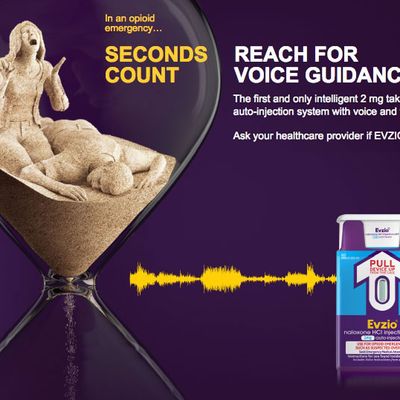
The opioid epidemic has been very bad for America, but very good for the overdose-antidote business. Since 2014, tens of thousands of Americans have died by overdosing on opioids — and the price of one lifesaving overdose cure has risen by 500 percent.
Naloxone hit the market in 1971, as the first drug for reversing an opioid overdose, and has been off-patent for decades. But with overdose antidotes, delivery systems matter: There isn’t always time to get a sufferer professional help, which means a naloxone product’s ease of use can mean the difference between life and death.
Kaleo was first conceived as a competitor to EpiPen, which has also (infamously) found that people are willing to pay a high price for easy-to-use, lifesaving drugs. But as the opioid epidemic grew, Kaleo realized its injector devices could work just as well for dispensing naloxone.
This insight resulted in Evzio, an injector with a built-in voice recording that talks the user through the process of injecting the drug. This feature is genuinely valuable — it has made Evzio the first nalaxone injector that can be used by anybody, not just doctors and first responders. That innovation allowed Evzio to capture 20 percent of naloxone’s retail market in 2015 and 2016. It also allowed Kaleo to raise Evzio’s price from $690 in 2014 to $4,500 today.
To be fair, Kaleo has paired its price-gouging with a heavy dose of charity: The company has donated large numbers of its devices to cities and drug-treatment programs.
But Kaleo’s generosity hasn’t kept up with demand, and its donation supply was exhausted by July of last year. Further, by charging its paying consumers a price exponentially higher than the cost of production, the company has made its device impossible to access for many buyers that desperately need it — including the state of Vermont.
And it isn’t just Kaleo. Other naloxone makers are also responding to rising demand by jacking up prices. According to a new paper in the New England Journal of Medicine, the cost of Hospira’s injectable increased from $62.29 in 2012 to $142.49 today, while Amphastar’s naloxone nasal spray has risen by 95 percent since 2014.
Shaming individual companies and pharmaceutical CEOs for hiking the price of drugs is easy. Also fun. And somewhat effective.
But America could really use a better mechanism than spiteful memes of Martin Shkreli for controlling pharmaceutical costs. Like, for example, joining every other developed nation in letting the government enact price controls on lifesaving drugs.
Fortunately, America just elected a populist president who was propelled into power by communities suffering from the opioid epidemic — and who has promised to take on Big Pharma and bid down the price of drugs.
Unfortunately, that president is actually a con man who scratched that plan after meeting with pharma lobbyists earlier this week.






























